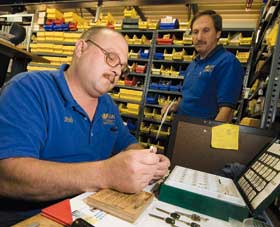  |
| HOME | THIS ISSUE | CALENDAR | GRANTS | BACK ISSUES | < BACK | NEXT > |
Locksmiths hold key to evolving University landscapeby Kala Kachmar - August 27, 2007 | ||||
| Being responsible for more than 102,000 keys can’t be easy. But Paul Brazeau, UConn’s locksmith department supervisor, has it all locked up. The locksmith department, part of the Division of Public Safety, is responsible for the locks and keys of more than 120 buildings at the Storrs and Depot campuses. Locksmithing began as the art of shaping and molding small metal pieces to make keys and locks for cabinets, businesses, homes, and cars. Modern locksmiths are responsible for more complex locks, key control systems, and the overall security of a unit. When the locksmith department at UConn was created in the1940s, there was just one locksmith. Today, the changing landscape of UConn keeps four full-time locksmiths – each of whom has 20 years or more of locksmith experience – busy. Eighty-seven major building projects have been completed since the start of UConn 2000, and that has added more to the long “to-do” list of those engaged in this craft. UConn locksmiths attend all construction-related meetings on campus and set standards to ensure that appropriate locks will be used in new and renovated buildings. “It’s important to determine what kind of locks will be used before the job starts,” Brazeau says. “We talk to the department to find out their needs, and we suggest the locks with the highest level of security that will fit the budget.” August is the busiest time for the locksmiths, as they prepare residence hall locks and keys for students coming to campus in the fall. If a dorm room key was not returned at the end of the school year, the lock must be replaced. The locksmith department has plans to re-key all of the nearly 7,000 dorm rooms on campus, to make the doorknobs handicap accessible. This summer, the department replaced the 268 locks at Ellsworth Hall in the Hilltop dormitories as a first step. The University locksmiths’ tasks include programming and repairing electronic lock systems, which have been in use since 1998. Electronic locks, usually found on the doors of high-tech classrooms and the exterior doors of residence halls, are opened with cardkeys. The locksmiths recently updated the cardkey system to accept the new Husky OneCards that were distributed at the beginning of the summer. The encryption code on the electronic system had to be changed to match those on the Husky OneCards. The electronic system has an added security benefit.
“We can do an audit trail to track who has unlocked the door if we need to,” Brazeau says. The locksmiths often work closely with the police and fire departments to keep the campus safe by responding to calls when a key is lost or stolen, or when there is a break-in. “Locksmiths are in regular contact with the police and fire departments, and are considered part of the essential services on campus,” says Lauren Barrett, public safety operations manager. “The departments have a history of working well together. It provides an excellent emergency response system.” At least one locksmith is on call 24 hours a day. “Lost keys, stolen purses, and break-ins can happen at any time,” adds Brazeau. “The security of a building is always a priority for us, no matter what time it is. Safety comes first.” Barrett says the department is committed to making sure the right keys are in the right hands. The staff monitors key control records, and ensures that the information on who has access to what places is up-to-date. “The population of this campus is changing all the time, so we have to be in contact with every department,” she says. The department has to stay on top of locksmith know-how, including new equipment and methods as they become available. “We attend state-of-the-art training and locksmith conventions to keep up with technological changes,” says Brazeau. “They often introduce new, time-saving equipment to us.” Last year, for example, the locksmiths began working with a key cutter machine that recognizes and cuts a key by its serial number, instead of using an actual key to make a copy. Another device stamps a key automatically with its serial number. Previously, locksmiths had to manually pound the numbers into keys. Records of serial code numbers for keys, which used to be handwritten, are now computerized. “We streamline the equipment,” says Barrett, “so the job is cost effective, less labor intensive, and more efficient.” Kala Kachmar, a junior majoring in journalism, is a student in the Honors Program. |
| ADVANCE HOME UCONN HOME |

